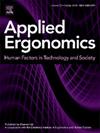Sick of being driven? – Prevalence and modulating factors of carsickness in the European population in context of automated driving
IF 3.4
2区 工程技术
Q2 ENGINEERING, INDUSTRIAL
引用次数: 0
Abstract
As in automated driving the driver becomes a passenger, carsickness might reduce comfort for susceptible individuals. Insights in the prevalence of carsickness and its modulating factors are considered useful for the development of automated vehicles to mitigate or prevent its occurrence. An online survey was conducted with N = 3999 participants in Spain, Sweden, Poland, and Germany. 30 % of participants reported to have already experienced carsickness as adult. The frequency of carsickness was modulated not only by demographic factors (country, gender, age), but also by frequency of being a passenger, type of non-driving related task, road type, and the seating position in car. Furthermore, the efficiency of applied countermeasures, temporal aspects of carsickness development, as well as the relation of carsickness with the acceptability of automated driving and the effect on subjective fitness to drive was investigated. The results are discussed with focus on automated driving.
厌倦了被人开车?-在自动驾驶背景下,欧洲人口晕车的患病率和调节因素
就像在自动驾驶中,司机变成了乘客一样,晕车可能会降低易感人群的舒适度。人们认为,对晕车患病率及其调节因素的深入了解,有助于开发自动驾驶汽车,以减轻或预防晕车的发生。在西班牙、瑞典、波兰和德国进行了一项在线调查,共有3999名参与者,其中30%的参与者报告说他们在成年后已经经历过晕车。晕车的频率不仅受到人口因素(国家、性别、年龄)的影响,还受到乘客的频率、与驾驶无关的任务类型、道路类型和车内座位位置的影响。此外,还研究了对策的有效性、晕车发展的时代性、晕车与自动驾驶可接受性的关系以及对主观驾驶适应性的影响。研究结果以自动驾驶为重点进行了讨论。
本文章由计算机程序翻译,如有差异,请以英文原文为准。
求助全文
约1分钟内获得全文
求助全文
来源期刊

Applied Ergonomics
工程技术-工程:工业
CiteScore
7.50
自引率
9.40%
发文量
248
审稿时长
53 days
期刊介绍:
Applied Ergonomics is aimed at ergonomists and all those interested in applying ergonomics/human factors in the design, planning and management of technical and social systems at work or leisure. Readership is truly international with subscribers in over 50 countries. Professionals for whom Applied Ergonomics is of interest include: ergonomists, designers, industrial engineers, health and safety specialists, systems engineers, design engineers, organizational psychologists, occupational health specialists and human-computer interaction specialists.
 求助内容:
求助内容: 应助结果提醒方式:
应助结果提醒方式:


